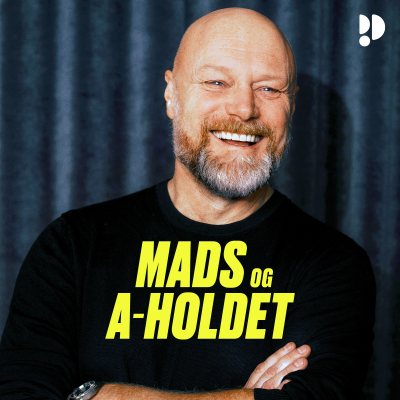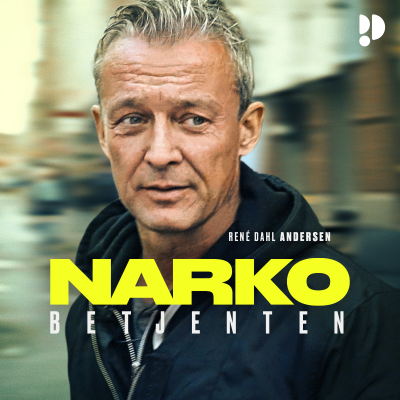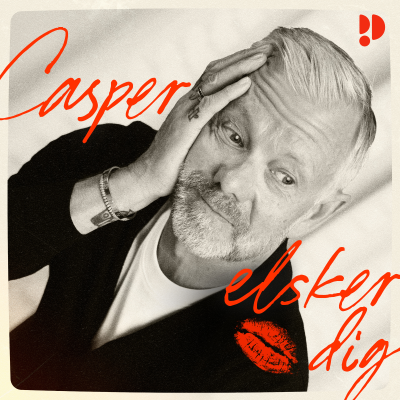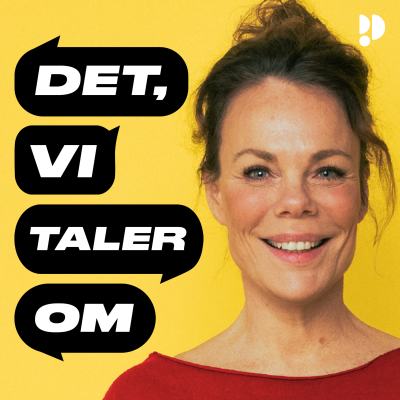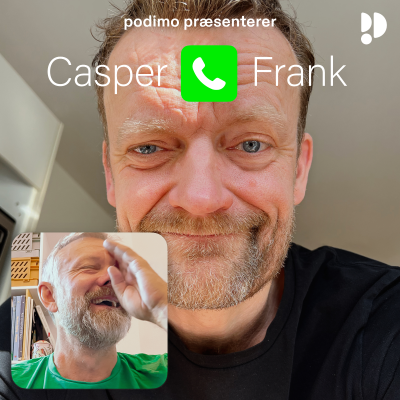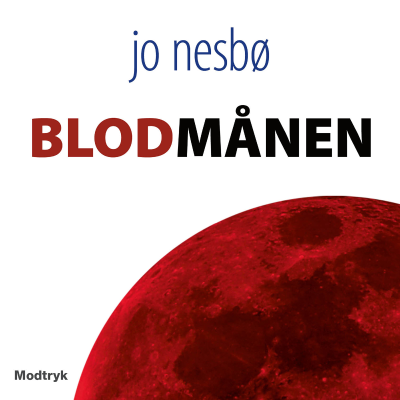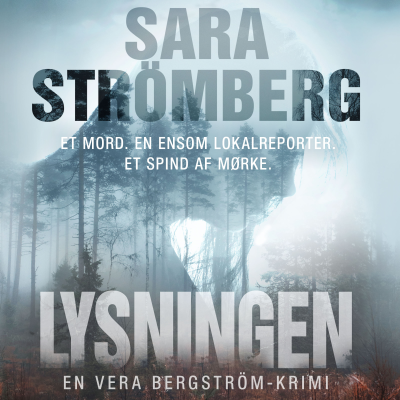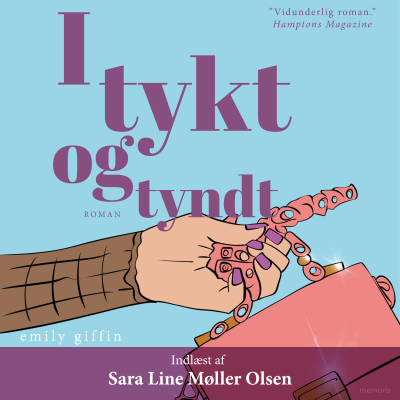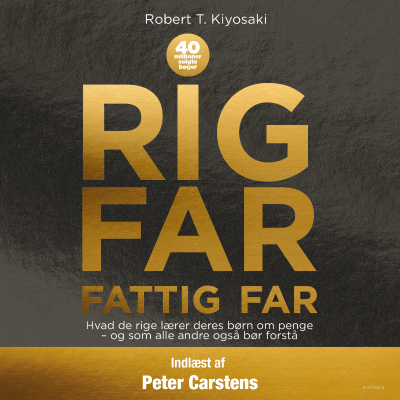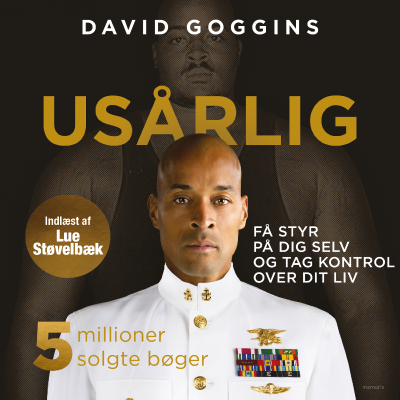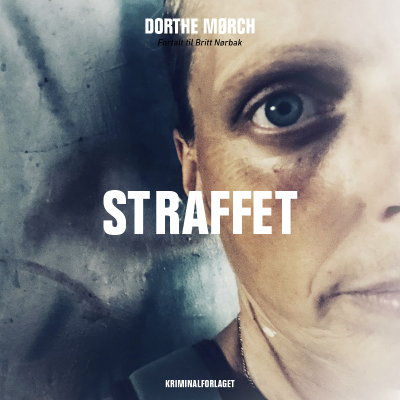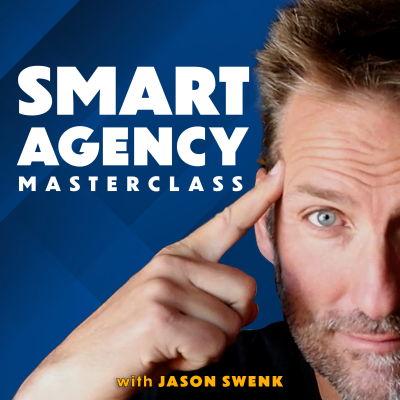
Smart Agency Masterclass with Jason Swenk: Podcast for Digital Marketing Agencies
Podcast af Jason Swenk
Begrænset tilbud
1 måned kun 9 kr.
Derefter 99 kr. / månedIngen binding.
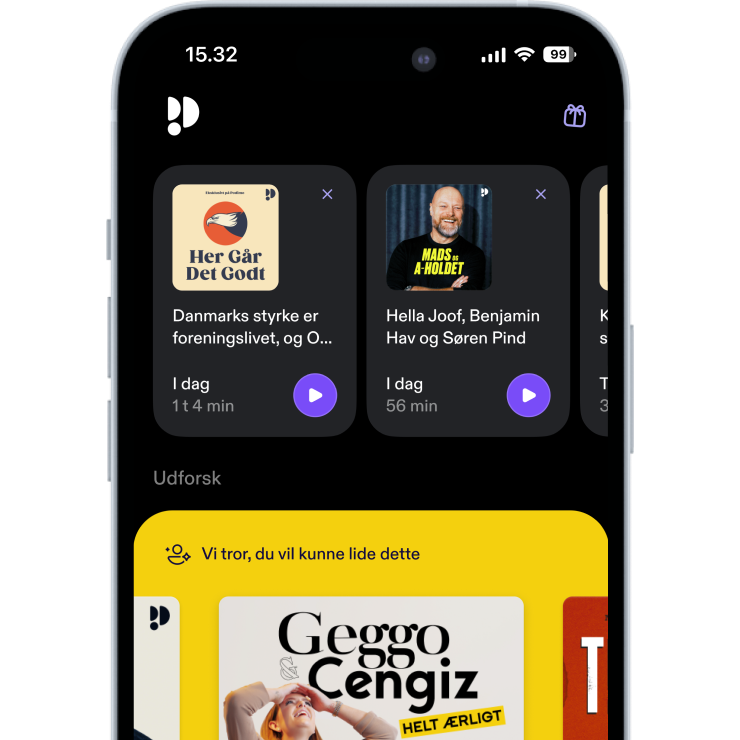
Mere end 1 million lyttere
Du vil elske Podimo, og du er ikke alene
Rated 4.7 in the App Store
Læs mere Smart Agency Masterclass with Jason Swenk: Podcast for Digital Marketing Agencies
Growing an agency is very difficult, and you might feel unclear what to do next in order to grow and scale your agency. The Smart Agency Masterclass is a weekly podcast for agencies that are wanting to grow faster. We interview amazing guests from all over the world that have the experience of running successful businesses, and will provide you the insights you need. Our podcast is just over 3 years old, and have reached more than a half million listeners in 42 countries.
Alle episoder
867 episoderWould you like access to our advanced agency training for FREE? https://www.agencymastery360.com/training [https://www.agencymastery360.com/training] Are you stuck chasing new clients while ignoring the goldmine in your past customer list? Does your agency feast on projects but starve for predictable revenue? Today’s featured guest knows what it’s like to hit a growth ceiling and being tired of the one-and-done client hamster wheel. He shares how he pivoted his agency after becoming a HubSpot partner, why he turned to project-based work after customer habits changed following the pandemic, and how he got out of the dreaded “no man’s land”. Eric Baum is the CEO and founder of Bluleadz [https://www.bluleadz.com/], a HubSpot Onboarding and Implementation Agency dedicated to transforming the way companies market, sell, and service their customers through the power of the HubSpot platform. He’ll discuss his cash flow challenges, pricing mistakes that almost tanked the business, and how EOS helped him escape “no man’s land.” If you're stuck in the fulfillment hamster wheel or scaling past $5M feels like pushing a boulder uphill... listen up. In this episode, we’ll discuss: * Reinventing his agency as a HubSpot partner. * The real scaling struggle: cash flow. * Why project-based doesn’t mean profitless. * Strategic partnerships are the future. Subscribe Apple [https://podcasts.apple.com/us/podcast/smart-agency-masterclass-jason-swenk-podcast-for-digital/id870206013] | Spotify [https://open.spotify.com/show/0FiKuRTpkJ7OraCJBUIlr9] | iHeart Radio [https://www.iheart.com/podcast/263-smart-agency-master-28334260/] Sponsors and Resources E2M Solutions: Today's episode of the Smart Agency Masterclass is sponsored by E2M Solutions, a web design, and development agency that has provided white-label services for the past 10 years to agencies all over the world. Check out e2msolutions.com/smartagency [http://e2msolutions.com/smartagency] and get 10% off for the first three months of service. Accidental Founder, Intentional CEO Back in the Yellow Pages era, Eric was running two service-based franchises and needed a better way to market them. He brought marketing in-house for PPC, SEO, web dev, and that hire didn’t just turn things around. It turned into a new business. Fast-forward a few months, and other franchise owners across the country started asking for help. Eric spun that in-house team into an agency, and had 50 clients out of the gate. As many owners before have admitted to, Eric started out charging way too low—$250 to $500/month. “I don’t know how I didn’t go broke right out of the gate,” he laughs. And if you’ve ever undercharged in the early days, you’ll feel that one deep in your soul. Reinventing the Agency (and Himself) Around HubSpot The turning point came when Eric discovered HubSpot and pivoted Bluleadz to become a certified partner. That’s when the “real” agency began, as he started to study the industry and figure out what he had to do to be profitable, take care of his team, and do it without necessarily doing all the sales work all the time. From there, Eric leaned into strategy, profitability, and systems. He stopped trying to be the everything guy and started building an agency that didn’t need him in the trenches every day. Fifteen years later, his agency isn’t just thriving. It’s structured, profitable, and on track to hit 8 figures. Life in “No Man’s Land” – The $1M to $5M Plateau After fifteen years in the industry and getting closer to the eight-figure mark, one of the things that most surprised Eric was getting stuck in the ugly middle: the zone between $1M and $5M where a lot of agency dreams go to die. Many call it “no man’s land,” and if you’ve been there, you know the pain. “It was up, down, up, down,” he says. “I’d grow, then lose key employees. Revenue would spike, then tank. I kept asking, ‘What am I doing wrong?’” The answer: a lack of structure. So about nine years ago, Eric implemented EOS (Entrepreneurial Operating System). That gave his agency the foundation it needed—vision, accountability, and a cadence to scale. It didn’t fix everything overnight, but it got the business out of reaction mode and into growth mode. The Real Scaling Struggle: Cash Flow Even with all that success, Eric’s biggest constraint today isn’t clients or talent. It’s cash. In the agency world, sometimes you can grow so fast [https://flatworm-caterpillar-3mha.squarespace.com/podcast/lessons-from-growing] that you can actually outpace your ability to fund it. As Eric explains, “Receivables stack up. You can’t hire, build, or invest without the cash reserves in place to hit the down terms.” For instance, just this year his agency was down 20% compared to last year because of all the uncertainty for businesses. Sound familiar? So far, Eric's solution has been airtight payment terms. They moved away from waiting on client deliverables and toward milestone-based billing. They typically charge: * 50% upfront * 25% after month one * 25% at month two or fixed date Not based on deliverables. Based on time. Why? Because waiting on clients kills momentum (and your margin). “We used to wait months to get that final 50%. Now we’re often 100% paid before a project is even done.” Moral of the story? Set clear terms and stop letting clients hold your agency hostage. Project-Based Doesn’t Mean Profitless If You Structure It Right Five years ago, 85% of Bluleadz’s revenue came from retainers [https://flatworm-caterpillar-3mha.squarespace.com/podcast/8-figure-agency-growth]. Then COVID hit. Buying behavior shifted fast. Clients wanted results without long-term commitments. So Eric pivoted hard into project work—today, 80–85% of their revenue comes from one-off HubSpot onboarding and implementation projects. That means 50–75 new customers per month, each on 30 to 90-day timelines. The lesson: project-based doesn't have to mean chaos - if you systemize delivery and payment. However, Eric does admit he and his team had been failing to recapture clients for a second or third project. “We were just focused on getting new clients through the door.” Instead of nurturing clients post-delivery, they handed off the project and moved on. Meanwhile, past clients drifted—only to come back a year or two later in total chaos saying, “We lost our HubSpot guy. Can you help?” The opportunity cost was massive. They are currently working on recapturing these relationships. By reselling past clients, his agency could double or triple revenue in a year. The Triple-Team Model: Sales, CSM, Implementation In their efforts to start creating more lifetime value for customers, Eric’s agency introduced Customer Success Managers (CSMs)—not just to check in, but to hunt for value. CSMs dig into each client’s needs post-project, surface upsell or cross-sell opportunities, and feed them back to the sales team. Now they’re farming the base, increasing LTV, and stacking wins without chasing cold leads. This third new role adds a new layer to his team’s structure, which he now breaks down as: * Salespeople close net-new deals and join key milestone calls. * Implementation Specialists own delivery and are the client’s main point of contact. * CSMs sit above delivery, watching for success gaps, retention issues, and upsell opportunities. “Salespeople are hunters, not farmers. Trying to make them farm didn't work. So we changed the model.” This layered structure gives clients clarity, keeps teams focused, and ensures no growth opportunity slips through the cracks. Strategic Partnerships Are the Future Another key reason Bluleadz is scaling so quickly is partnerships. They're one of HubSpot’s top onboarding partners, and at one point this partnership drove most of his agency’s net new leads. More recently, however, as they start to expand their efforts to engage past clients, only 40% of their leads come from HubSpot, while 30% comes from existing customers, and another 30% from their inbound marketing efforts, other strategic partners, and referrals. This makes for a more balanced pipeline: “Inbound, outbound, and strategic partnerships [https://flatworm-caterpillar-3mha.squarespace.com/podcast/the-art-of-helping-strategic-partnerships]”. Those are the three pillars in the Playbook. You’ve got ‘em dialed in. As for Eric, he’s all in on strategic partnerships, which he considers to be the way of the future. The One Thing Eric Would Do Differently If he could go back and give his younger self advice on agency ownership, Eric would say “Let go faster.” He held on too long to sales, finance, client services… all of it. And every time he finally let go, the agency grew again. Today, Eric has zero departmental responsibilities. His job is vision, strategy, and leadership—and it’s paying off. Do You Want to Transform Your Agency from a Liability to an Asset? Looking to dig deeper into your agency's potential? Check out our Agency Blueprint [https://www.agencymastery360.com/blueprint]. Designed for agency owners like you, our Agency Blueprint helps you uncover growth opportunities, tackle obstacles, and craft a customized blueprint for your agency's success.
Would you like access to our advanced agency training for FREE? https://www.agencymastery360.com/training [https://www.agencymastery360.com/training] Are you still running your agency like it’s 2010? You know the setup: rigid roles, top-down management, a “just get it done” culture. If that sounds like your agency, chances are you’re the bottleneck. You’re stuck in the weeds, making every single decision, dealing with high churn, and wondering why output is low despite how hard everyone’s working. This is the story for most agency owners at the 7-figure stage. But the agencies scaling fastest today have evolved—and we’re breaking down exactly how. Why Most Agencies Get Stuck Most agency owners didn’t plan to be CEOs. You were good at strategy, sales, design, or delivery. Then suddenly—boom—you’re the boss. Now the team looks to you for every decision, every review, every answer. The problem isn’t your team. It’s the lack of vision. When there’s no clear direction, your team can’t lead themselves—because they don’t know where the hell they’re going. Once I clearly communicated the mission—“We’re building the resource I wish I had”—everything changed. Decisions got made without me. Accountability rose. That’s what happens when people lead toward a clear goal. Key shift: You don’t need more doers. You need more leaders. Attracting A-Players (Not Babysitting B-Teamers) A-players cost more—about 20% more on paper—but they produce 10–20x more than your average B-level staffer. They don’t need to be told. They take ownership. So how do you attract them? Build a brand people want to belong to. Ramblin Jackson, one of our mastermind members, calls their team “Ramblers.” It’s fun. It creates identity. It’s not just a job—it’s a tribe. Make your job posts feel like sales letters. “Here’s who we are. Here’s why it matters. Here’s what you’ll help us build.” Ramblin even walks candidates through the hiring process on their site to build trust. Put your team on display. Show them off on your website, on social, in your wins. A-players don’t just want just a job, they want purpose. Make it visible. Building a High-Performing Culture Great teams don’t happen by accident. They’re built on clarity, feedback, and connection. Here’s how to build a culture that scales: * Communicate Clearly. Use Looms instead of emails. Weekly standups. Show people what winning looks like—and support them to get there. * Give & Receive Feedback. Quarterly ask: What should we start, stop, and continue doing? Then actually do something with those answers. * Support Growth Paths. Not everyone wants to lead. Some want to be elite specialists. Either path is valuable—support both. * Forge Connections on Purpose. Especially if you’re remote. Retreats, local meetups, even casual Zooms help remind your team: we’re building something together. * Stop Managing. Start Coaching. Reviews are fine. But coaching is where the magic happens. Ask your team: “Where do you want to grow?” “What ideas do you have to help the company grow?” You’re not just managing performance—you’re investing in potential. Then teach them the 131 Method to make better decisions without you: * 1 What’s the issue? * 3 What are 3 possible solutions? * 1 What’s your one recommendation? This trains your team to think like owners. Also: stop assigning tasks—start assigning outcomes. Let them figure out the how. Debrief when things go sideways, but stop micromanaging. Growth comes from ownership. Sustainability Is the Long Game You can’t grow a team if they’re burned out, checked out, or walking out. Here’s how to protect your team’s energy: 1. Cut the fluff meetings 2. Encourage real time off 3. Create space for recovery (mental health days, no-meeting weeks) 4. Celebrate wins publicly (Slack shoutouts, weekly recaps) 5. Keep people connected—virtually and IRL Culture isn’t perks. It’s how people feel when they’re building with you. The traditional agency model is broken. You don’t need more hands—you need more heads. Build a team of leaders. Create a culture of clarity, connection, and coaching. Get out of the damn way—and let them fly. If you’re ready to attract better clients and become uncuttable, check out the Attract Masterclass [https://pages.agencymastery360.com/attract/]. It will help you position your agency to pull in the right leads instead of just more leads.
Would you like access to our advanced agency training for FREE? https://www.agencymastery360.com/training [https://www.agencymastery360.com/training] Are you a CEO still caught in the weeds of day-to-day operations? If so, you're not building a truly scalable business. Today’s episode is here to help you shift that mindset. Our featured guest is a CEO who has grown his agency by focusing on smart leadership—prioritizing culture, developing strong management structures, and intentionally making himself less essential to every meeting. Like many agency owners, he once believed he had to outwork everyone to prove his worth. But over time, he discovered that the agency performs better when he leads with vision instead of constant presence and that CEOs don’t need to be grinding to be effective. In this conversation, he shares how he came to that realization, what it’s meant for his agency’s growth and client success, how he built a trusted A-team, and more. Kevin Miller is the co-founder and CEO of Gr0 [https://gr0.com/], a performance marketing agency that’s exploded from startup to 200+ clients and over 80 full-time staff in just five years. Before launching GR0 in 2020, Kevin cut his teeth at Google, served as Director of Growth at OpenDoor, and was inspired to jump into the agency world by a friend who built and sold one of the first Facebook-focused DTC agencies. His background in SEO and paid media, combined with experience at both bootstrapped and venture-backed companies, gives him a rare, well-rounded perspective. Today his mission is clear: build a high-performance team that wins together. In this episode, we’ll discuss: * Two levers to driving growth. * Why CEOs are more effective when they’re not grinding. * Understanding that delegation is not optional. * Client acquisition that doesn’t feel like sales. Subscribe Apple [https://podcasts.apple.com/us/podcast/smart-agency-masterclass-jason-swenk-podcast-for-digital/id870206013] | Spotify [https://open.spotify.com/show/0FiKuRTpkJ7OraCJBUIlr9] | iHeart Radio [https://www.iheart.com/podcast/263-smart-agency-master-28334260/] Sponsors and Resources This episode is brought to you by Wix Studio: If you’re leveling up your team and your client experience, your site builder should keep up too. That’s why successful agencies use Wix Studio — built to adapt the way your agency does: AI-powered site mapping, responsive design, flexible workflows, and scalable CMS tools so you spend less on plugins and more on growth. Ready to design faster and smarter? Go to wix.com/studio [https://www.wix.com/studio] to get started. Getting to See the Possibilities of the Agency Space Watching a friend grow and sell a Facebook-focused DTC agency helped Kevin clearly see the differences between growing a bootstrap business versus a venture-capital backed business. His friend ended up selling the business for over $100 million, which Kevin hadn’t think it was possible to do in the agency space. It was an inspiring moment that led to the realization that he too could build and scale his own business, which he chose to do in the SEO niche. From Zero to 200 Clients: The Growth Playbook With just half a decade in the agency business, Kevin can see most people just can’t handle it. “Every day is a different game of guacamole with all sorts of people problems.” After all, in this business our product so the best way to guarantee you’re creating a safe environment where people want to stay is to over index on culture. This is how a young agency can go from scrappy startup to 8-figure beast in half a decade. It’s all about building a culture that attracts and retains A-players. If your account manager leaves, that client feels like they have to start over. It can be the worst experience for a client and the best way to avoid is to create an environment where everyone feels like part of a team. Kevin runs GR0 like an NBA franchise where everyone’s expected to perform at a high level, without being a burnout factory. He’s also very strict about behavior. No matter how talented you are, you can never be rude to a client or other employees. It’s a team-first culture with high accountability and even higher standards that has grown fast by keeping people, delivering great work, and staying crazy responsive. Two big levers driving their growth: Kevin attributes his agency’s success with client to two main elements: * Rapid response times: Emails, texts, Slack messages… they don’t sit idle. * Obsession with client results: Deliver, retain, and let referrals do the work. Additionally, he knows it’s not all about attracting new business. Churn is a killer. Retention isn’t sexy, but it’s the secret to compounding revenue. Inside the Org Chart: A 5-Level Machine In terms of the deals the agency is closing with clients, Kevin is a big believer that there’s little room to do great work on a monthly basis, which is why he prefers offering six-month contracts that will later get renewed for another six months. He’s also put a lot of thought into the agency’s organizational structure, which he breaks down into five levels: 1. Executive Team 2. VPs 3. Associate VPs / Directors (each running a service line) 4. Campaign Managers 5. Contractors & Specialists As to him, his role as CEO is divided into three categories: * Coach – Recruiting and leveling up 10x talent across the top team. * Closer – Still active in sales, he sets expectations and closes high-value clients. * Visionary – Driving innovation like launching new services (radio is next!) and adopting tools like ChatGPT for smarter, faster workflows. You’ll Be Needed Less & Less as a CEO – and That’s Okay Being a CEO won’t necessarily come naturally to everyone, which is why Kevin has a coach that has taught him how to conduct himself and cast the vision for the agency. He’s also embraced the fact that putting together a capable team will mean getting told they don’t need you to pitch in on every meeting. “If someone doesn’t need me in a meeting, I’m relieved. It means we’ve built something scalable.” A true leader should be helpful and keep the company moving forward, which is why Kevin sees his role more as someone who works for everyone at the company, as opposed to the old model where bosses were tyrants that barked orders all day. It’s not easy to lead 200+ employees, and leaders nowadays recognize that the way to do so is not just having a very strong team but also being able to keep them by building a great culture. From Hustle Mentality to Smart Leadership Kevin and Jason both admit they had to unlearn the “first one in, last one out” badge of honor. Many leaders tend to think they have to outwork everyone. Kevin admits he still wrestles with showing up early to prove value—even though the company runs better when he focuses on vision, not presence. The truth is agency CEOs don’t need to be grinding to be effective. They need to be accessible, and they need to build teams that run without them. “If I’m on a mountain or a golf course, and I get a call, I’ll answer. But if the team doesn’t need me? Even better,” Jason shares. This shift, from being the engine to being the guide rail, is one most agency owners struggle with. But letting go (and training others to step up) is the only way you get out of the weeds. Delegation Isn’t Optional—It’s Leadership 101 Early on, Kevin believed only he could do the work “right.” But that mindset capped his growth—and created unnecessary pressure. Effective delegation and believing in your team [https://flatworm-caterpillar-3mha.squarespace.com/podcast/effective-delegation] is what makes a great CEO. As he says now, “you have to pass the ball and trust they’ll show up.” If you're asking, “How should we do this?” you're already in the weeds. The better question is, “Who on my team should own this?” If you need ideas, start with Jason’s 1 3 1 method to train team decision-making is a killer takeaway: 1: What’s the problem? 3: What are three ways to solve it? 1: What do you recommend? It’s a simple leadership tool that trains independence—so you’re not the bottleneck every time something needs approval. You Can’t Build Big if You Can’t Let Go If you want to make sure you have people on your team who’ll step up after applying the 1 3 1 method, hire people who can manage themselves. Kevin and Jason both agree they’re not built to manage micro-tasks—or people who need micromanaging. “If I’m going to manage someone, I’ll expect them to do it like me, at my pace, with my level of commitment. And that’s not fair,” Kevin admits. As owners, your growth is capped by how much you think you have to do. Build a team of leaders—not followers. Give direction, not checklists. And accept that mistakes are part of the process. In the mastermind, Jason and the members celebrate even the failures—because sharing missteps keeps others from repeating them. That’s how real learning happens. Client Acquisition That Doesn’t Feel Like Sales Now let’s talk lead gen. How did Kevin’s agency bring in over 200 clients? It wasn’t ads. It wasn’t cold emails. It was strategic referrals [https://flatworm-caterpillar-3mha.squarespace.com/podcast/the-art-of-helping-strategic-partnerships]—and they engineered that pipeline from the ground up. In Kevin’s view, cold acquisition just doesn’t work well with the amount of competition in his space. Instead, he built a network of warm referrals of ~25 trusted partners. Each partner gets 10% of the monthly revenue from any referred client. But more importantly, they only recruit partners who already know Kevin and trust his team to deliver. “I’m not reaching out cold saying ‘hey, I’ll pay you 10%.’ I’m building real relationships with people who already trust me.” This warm referral engine is the opposite of passive referrals. It’s intentional, proactive, and mutually beneficial. It scales because Kevin didn’t wait—he built the network years before launching GR0. Most of the time referrals aren’t scalable. However, when you do it this way—proactively recruiting the right partners—it becomes a one-to-many strategy. This is a model more agency owners should be thinking about. It’s lower friction, higher trust, and most importantly: it cuts through the noise in a saturated market. Pricing, Positioning, and Playing the Long Game One thing Kevin admits he should be raising prices more often [https://flatworm-caterpillar-3mha.squarespace.com/podcast/8-figure-agency-growth]. GR0 started with $3,000/month clients and now charges $8K–$10K for the same package. But that evolution took five years. Still, their market positioning is clear: “We’re expensive but fair. Not overpriced, not low-budget. Right in the sweet spot.” This ties back to the trust built with clients and referral partners alike. If the value is real and the results are consistent, the relationships last. Do You Want to Transform Your Agency from a Liability to an Asset? Looking to dig deeper into your agency's potential? Check out our Agency Blueprint [https://www.agencymastery360.com/blueprint]. Designed for agency owners like you, our Agency Blueprint helps you uncover growth opportunities, tackle obstacles, and craft a customized blueprint for your agency's success.
Would you like access to our advanced agency training for FREE? https://www.agencymastery360.com/training [https://www.agencymastery360.com/training] Agency owners often stay stuck in delivery because they fear stepping back will tank what’s working. Brent Weaver shares how he transitioned from being the “product” to leading a 300-person agency without burning it all down—and why you need to step up if you want to scale. What You’ll Learn * Why staying “in delivery” caps your growth * How to stop being the product and build leaders around you * How to set a real “North Star” so your team stops bugging you * Why you need to know your numbers and stop blaming seasonality * The mindset shift from VFR (gut decisions) to IFR (data-driven scale) Key Takeaways * Your agency won’t scale if you’re stuck in delivery. You must step back and coach leaders if you want freedom and growth. * Clarity kills chaos. Set a clear vision so your team can act without needing you in every decision. * Use the 1-3-1 method (1 problem, 3 options, 1 recommendation) to build leaders and stop being the fixer. * Know your numbers. Seasonality is often a scapegoat for pipeline problems you can fix. * Every change costs churn. If your change won’t grow you by at least 20%, it’s not worth the churn. * Stop flying VFR. Use data to run your agency if you want to scale without chaos. Are you still viewed as a ‘product’ of your agency? Maybe you’ve considered stepping back from the day-to-day but are terrified you’ll break what’s working. Our featured guest is the newly appointed CEO of E2M Solutions and he shares what it’s been like going from being the main “product” at an agency he built and grew, to stepping in to run a 300-person white-label agency. From losing the fear of breaking what already worked to accepting it’s better if he’s usually not in client call, he explains how he’s grown comfortable in his new role: coaching the core leadership team, amplifying culture, and making sure hundreds of projects and thousands of tasks get executed well. Brent’s journey is packed with lessons on what real leadership looks like when you’re ready to grow. Brent Weaver is the CEO of E2M Solutions [https://www.e2msolutions.com/], a 300-person white-label agency helping digital agencies scale through web, digital marketing, and AI services. Before E2M, Brent founded and grew UGURUS, supporting agencies to niche, price, and position better. Now, instead of talking about scaling, he’s deep in the trenches doing it. In this episode, we’ll discuss: * Stop being the product and build leaders around you * How to set a real “North Star” so your team stops bugging you * Why you need to know your numbers and stop blaming seasonality Subscribe Apple [https://podcasts.apple.com/us/podcast/smart-agency-masterclass-jason-swenk-podcast-for-digital/id870206013] | Spotify [https://open.spotify.com/show/0FiKuRTpkJ7OraCJBUIlr9] | iHeart Radio [https://www.iheart.com/podcast/263-smart-agency-master-28334260/] From “Gainfully Unemployed” to Leading 300 People A few months before stepping in at E2M, Brent was living the dream [https://flatworm-caterpillar-3mha.squarespace.com/podcast/life-post-exit-brent-weaver]: building a halfpipe in his barn and enjoying long walks on his property. Then, he jumped back in, this time not to build a new business, but to lead a 300-person agency that already had a killer product, a strong culture, and a commitment to service. Brent’s move is the dream scenario for many agency owners who’ve spent years in the grind. He joined a team that’s already winning and is in the process of figuring out how to take it to the next level [https://flatworm-caterpillar-3mha.squarespace.com/podcast/acquisition-strategy-for-rapid-agency-growth] without screwing it up. However, running an operation that serves hundreds of clients and handles hundreds of projects every month, the stakes are bigger, the team is bigger, and the impact is bigger. It’s a different kind of pressure. When You’re No Longer “The Product” If you’re running a 5–20 person agency, you might feel like stepping up to a 300-person team would just mean 300 people interrupting you all day with Slack pings. But Brent that’s not how it works at that level. If you want to scale, you have to stop being the product. At UGURUS, Brent was often the one jumping on client calls [https://flatworm-caterpillar-3mha.squarespace.com/podcast/brent-weaver-what-happened-ugurus] to “fix it.” At E2M, he’s focused on coaching the core leadership team, amplifying culture, and making sure hundreds of projects and thousands of tasks get executed well without him being the bottleneck. As he explains, even though he loves speaking to clients, there probably shouldn’t be a situation where he HAS to jump on a call with them. Brent believes agency owners should begin stepping back from daily agency operations once the team team grows to around 20 people. At this point, you should start to think about your business’s leadership structure, management structure, and spend more time thinking about the “middle” of the business vs. just the vision. Take note: If you’re stuck in delivery and putting out fires, your agency won’t scale. Vision: Your Agency’s North Star If you’ve heard agency owners talk about the business “North Star,” you know how critical it is to set a clear vision your team can rally around. Your vision doesn’t need to be some sappy paragraph you read before standups. It needs to be clear enough [https://flatworm-caterpillar-3mha.squarespace.com/podcast/chaos-to-clarity-thriving-agency] that everyone on your team can make decisions aligned with where you’re going without bugging you every five minutes. At E2M, Brent and his team know exactly where they’re headed over the next three to five years—and every decision flows from that. This is true freedom to Brent. His vision of freedom is not one where he has lots of time off, but rather one where he can do his job as CEO without being micromanaged and can choose his path towards the agreed strategic objectives. If you want to stop being the product at your agency and you still don’t have this clarity, your team will constantly come to you, expecting you to make every call. If you want to get out of that cycle, set your North Star. Then, overcommunicate it. The 1-3-1 Method to Building Leaders If you’re still solving every problem in your agency, try the 1-3-1 method Jason used: * What’s the 1 problem you’re facing? * What are 3 options you’ve considered? * What’s the 1 you recommend? Teach your team to think critically and solve their own problems, and you’ll stop being the default fixer. This is how you build leaders inside your agency instead of becoming the only adult in an adult daycare. Don’t Let “Do No Harm” Paralyze You For Brent, being a good leader means getting down to why things are working or not working at the agency, with the same level of detail whether things are working or not. As a leader, if you don’t have a firm grip on the business and why it’s going up, down, or staying the same, you can’t get a clear idea of how to improve the company or not damage what’s working. New CEO’s often come in with the idea of “doing no harm” by changing things too much as they start. Think about it like this: Any meaningful change will cause about 20% churn. If the upside of your change isn’t at least 20% growth, it’s not worth it. Don’t be afraid of making changes. Just remember that if you decide to change the pricing, pivot your offer, or build a new division, it better be worth the churn it will inevitably create. This mindset frees you to take the swings that actually move your agency forward. The Seasonality Cop-Out If you truly have a firm grip on the business, you’ll also avoid the seasonality cop-out.. “Summer’s slow.” “Everyone’s on vacation.” “Budget freezes in Q4.” We’ve all heard it, but as Brent learned at Digital Ocean (where you either knew your numbers or got roasted), seasonality isn’t causality. If you see lead flow drop in the summer, don’t blame the weather. Look deeper: Are you running events that drive leads earlier in the year but have no Q3 pipeline activity? Do your ad campaigns pause when the kids get out of school? You don’t fix “seasonality” with wishful thinking. You fix it by identifying the root cause, putting numbers to the impact, and designing campaigns or partnerships to fill the gap. If you want next June to be different, start planning now. Clarity over confusion wins every time. Flying VFR vs. IFR: How Agency Owners Get Stuck With both the interviewer and interviewee being licensed pilots, we of course got this banger analogy when talking about decision-making for agency owners: * Visual Flight Rules (VFR): You fly by looking out the window, adjusting based on what you see. * Instrument Flight Rules (IFR): You fly by instruments, allowing you to go further, faster, and more safely. Most agencies operate under VFR, making gut decisions with limited data. This approach works when you’re small, but to scale, you need to fly IFR, building a data system that tells you what’s working, what’s not, and what needs fixing. At E2M, Brent is shifting the company to operate on data, allowing them to scale smarter and make big moves (like building out their AI and Go High Level divisions) with confidence. Do You Want to Transform Your Agency from a Liability to an Asset? Looking to dig deeper into your agency's potential? Check out our Agency Blueprint [https://www.agencymastery360.com/blueprint]. Designed for agency owners like you, our Agency Blueprint helps you uncover growth opportunities, tackle obstacles, and craft a customized blueprint for your agency's success.
Would you like access to our advanced agency training for FREE? https://www.agencymastery360.com/training [https://www.agencymastery360.com/training] With clients increasingly expecting their agencies to leverage AI, are you waiting for client direction, or leading the way on how to use it? Today’s featured guest has a unique vantage point on this shift. He runs a platform that connects clients with credible agencies while helping agencies showcase their expertise, giving him a front-row seat to what clients truly want and what agencies fear about AI. With hundreds of thousands of agencies on his platform, he’s seen firsthand that the agencies standing out are the ones leading the AI conversation, not waiting for permission to start it. He’ll share why educating your clients on the possibilities of AI is now a competitive advantage and how his company’s new verification layer aims to bring trust and clarity to an increasingly crowded agency marketplace. Tim Condon is the Chief Revenue Officer at Clutch [https://clutch.co/clutch-verified], the largest B2B service provider marketplace online, boasting over 300,000 agencies. Tim helps agencies showcase services, collect reviews, and attract qualified buyers. With a front-row seat to the challenges and wins of agencies across industries, Tim sees exactly how the best adapt—and how others risk falling behind. Tim has been on the show before with advice on how agency owners can separate from the pack [https://flatworm-caterpillar-3mha.squarespace.com/podcast/how-to-separate-from-the-pack] and position their agencies for success. In this episode, we’ll discuss: * Is AI coming for your agency? * Document your AI processes before it gets expensive. * How you should be starting the AI conversation. * The power of documented proof. Subscribe Apple [https://podcasts.apple.com/us/podcast/smart-agency-masterclass-jason-swenk-podcast-for-digital/id870206013] | Spotify [https://open.spotify.com/show/0FiKuRTpkJ7OraCJBUIlr9] | iHeart Radio [https://www.iheart.com/podcast/263-smart-agency-master-28334260/] Sponsors and Resources This episode is brought to you by Wix Studio: If you’re leveling up your team and your client experience, your site builder should keep up too. That’s why successful agencies use Wix Studio — built to adapt the way your agency does: AI-powered site mapping, responsive design, flexible workflows, and scalable CMS tools so you spend less on plugins and more on growth. Ready to design faster and smarter? Go to wix.com/studio [https://www.wix.com/studio] to get started. Is AI Coming for Your Agency? It Depends The elephant in every agency Slack channel: Will AI replace us? Tim sees a spectrum. Some agencies think they’re immune (“We only serve local dentists, so we’re safe.”), while others are already using AI to transform delivery, productizing what used to be manual labor into scalable SaaS products for other agencies. Most agencies are stuck in the middle - unsure where to begin and afraid to fall behind. Basically, if your clients are tech-savvy DIYers, yes, you’re at risk. But 99% of clients aren’t like that. They want the results AI brings, but they don’t want to build or manage it themselves. Hence, those who adopt AI to streamline delivery and elevate their positioning—not those who ignore it or just dabble, will win. AI Isn’t a Threat. It’s Your Edge AI is already making agencies faster, leaner, and more profitable if they leverage it correctly: * Custom GPTs [https://flatworm-caterpillar-3mha.squarespace.com/podcast/ai-agents-transform-agency-operations] for marketing, sales training, and operations * Automated research and lead qualification * Speeding up delivery while maintaining quality Tim shared an example of a San Francisco agency using LLMs to automate internal processes. It wasn’t complicated: structured folders, an AI model to search and output organized results. Simple, but powerful. If your agency isn’t at least experimenting with AI to remove repetitive manual work, you’re falling behind—not because AI will replace you, but because other agencies will outpace you by using AI to do what you do, faster and cheaper. Document Your AI Processes Now (Before It Gets Expensive) AI pricing today is like Uber in the early days: cheap to get you hooked, but it won’t last [https://flatworm-caterpillar-3mha.squarespace.com/insights/build-smart-before-ai-prices-surge]. AI’s current affordability is saving agencies the equivalent of multiple salaries annually. Eventually, these tools will increase in price to reflect their true value. What can you do about this? Jason recommends documenting your workflows and data used to train custom GPTs or AI agents now. If pricing spikes or a model goes down, you can pivot to another provider without losing your institutional knowledge. Why Agencies Must Shift from Order-Takers to Advisors Most agencies fail not because they lack skills, but because they act like order-takers. As a clients, it’s frustrating for Jason when agencies ask, “What do you want us to do?” instead of showing him what’s possible [https://flatworm-caterpillar-3mha.squarespace.com/podcast/keep-clients-longer]. Remember that as agencies, your purpose is to solve problems for your clients. Clients (dentists, local businesses, even large brands) don’t know what’s possible with AI. They think it’s just a fancy chatbot. If you step up to educate and advise clients on what’s possible with AI, you become indispensable. Look to build systems that: * Research prospects automatically before calls * Automate competitor and market analysis * Help clients leverage AI in their workflows Agencies that step into this advisor role, showing clients what’s possible and taking accountability for delivering results, become irreplaceable. You’re not just executing tasks; you’re creating outcomes they can’t create alone, and that’s where real value lies. Don’t Be Another “Nomad Agency.” Be the Real Deal Too many people who failed at running agencies pivot into teaching how to run an agency while living the “digital nomad” lifestyle, without having actually built sustainable businesses. This creates noise and mistrust in the marketplace, making it harder for real agencies to stand out. Most of the time, agency owners are accidental entrepreneurs—people who mastered a skill and were asked to help, not those who started for the lifestyle. If you’re listening to this, you’re likely the latter. To stand out, you need to showcase not just what you can do but what you’ve actually done. Your wins, client results, and case studies speak louder than lifestyle photos on Instagram. The Power of Specific, Documented Proof If you want to stand out from the fly-by-night agencies, talk specifics. Others mostly speak in generalities. Instead, credible agencies share specifics. If you can clearly articulate, “Here’s the exact problem we solved for a client just like you,” then you instantly separate yourself from the pack. Tools like Clutch help because they use AI to pull themes from your reviews to match buyer intent, but your agency still needs to collect, showcase, and share detailed case studies and client stories. Documentation matters. If you’re working with SMBs or mid-market clients, they want to see clear, verified results before investing. When you can present proof, it’s hard for low-quality competitors to compete, no matter how flashy their pitch decks look. Start gathering your “receipts” now to future-proof your positioning. Verification Adds Trust in a Crowded Marketplace Tim’s company Clutch now offers Clutch Verified [https://clutch.co/clutch-verified] as an additional trust layer. They don’t just take your word for it; they check your business registration, credit history, and operating longevity to separate real agencies from “gaming-the-system” players. It’s a powerful way to signal to potential clients, “We’re credible, stable, and vetted.” For clients, it’s a good indicator of who you’ll be working with and for agencies it becomes a sales asset. When potential clients research you on Clutch, verified agencies are prioritized, giving you an edge over competitors. It’s a practical, low-cost step to build trust and signal legitimacy, especially if you’re competing for premium clients. Do You Want to Transform Your Agency from a Liability to an Asset? Looking to dig deeper into your agency's potential? Check out our Agency Blueprint [https://www.agencymastery360.com/blueprint]. Designed for agency owners like you, our Agency Blueprint helps you uncover growth opportunities, tackle obstacles, and craft a customized blueprint for your agency's success.

Rated 4.7 in the App Store
Begrænset tilbud
1 måned kun 9 kr.
Derefter 99 kr. / månedIngen binding.
Eksklusive podcasts
Uden reklamer
Gratis podcasts
Lydbøger
20 timer / måned

